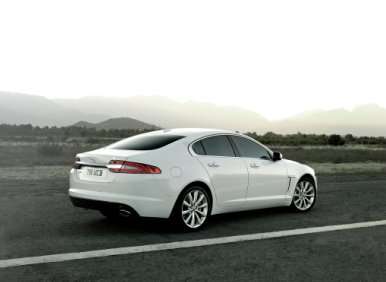Recent Articles
Popular Makes
Body Types
2013 Jaguar XF Supercharged Road Test & Review
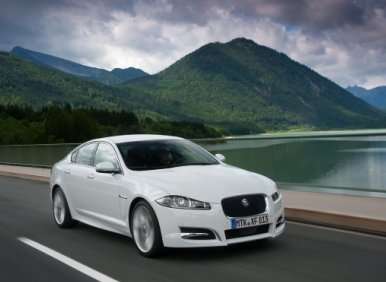
There are actually two supercharged powerplants in Jaguar’s 2013 XF line of cars. The Jaguar’s new 3.0-liter V6 is pressurized to produce 340 horsepower and 251 ft-lbs of torque. This engine supplants the 385-horsepower/380 ft-lb normally aspirated 5.0-liter V8 previously powering the small Jaguar saloon (that’s sedan for those of you not fluent in English-English).
Then there is the engine powering the “official” Jaguar XF Supercharged, the blown 5.0-liter V8. The subject of this review, we’ll get to the particulars of that car’s engine a bit later because there is another new powerplant available to Jaguar XF intenders for the 2013 model year. The base 2013 Jaguar XF model employs a turbocharged 2.0-liter four (the same engine the Land Rover Evoque uses to good effect). The turbocharged four delivers 240 horsepower and 251 ft-lbs of torque.
The other two supercharged Jaguars are the XFR and the XFR-S. Both use the same 5.0-liter V8, but are tuned for different levels of output. The XFR gets 510 horsepower out of the engine, while the XFR-S gets 550 horsepower. Both carry over from the 2012 model year.
Another new development for 2013 models is the addition of all-wheel drive to the list of Jaguar XF attributes. Those seeking four-wheel propulsion will get the 3.0-liter supercharged V6 as standard equipment. All of Jaguar’s supercharged engines use statrt/stop technology in an effort to improve their fuel economy.
The other new XF mechanical development for the 2013 model year is the incorporation of an all-new eight-speed automatic transmission across the board for the Jaguar sport sedan. The wider array of engine choices is expected to broaden the appeal of the Jaguar considerably by offering two versions of the car with better fuel economy, less weight, and a lower starting price.
2013 Jaguar XF Supercharged Road Test & Review: Models & Prices
Of course, if you’re interested in the “real” supercharged Jaguar XF, all of that probably matters little to you. In all likelihood you’re after the performance, pure and simple. You’re probably also swayed by the exceptionally generous array of luxury items fitted to the higher performance XF model.
Itself one of the models within the broader range of Jaguar XF offerings, the 2013 Jaguar XF Supercharged starts at $68,100. Complete model range pricing starts at $46,975 for the XF 2.0, $50,000 for the XF 3.0, $83,200 for the XFR, and $99,000 for the XFR-S.
Jaguar charges an additional $875 for destination and delivery.
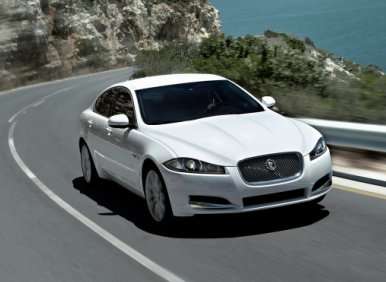
2013 Jaguar XF Supercharged Road Test & Review: Design
When the XF debuted in 2009, it signaled the continuation of a design revolution at Jaguar. Previously tied to a retro-inspired styling theme, Jaguar’s cars were somewhat anachronistic—but nice. Of course, in a competitive environment nice only gets a car so far.
Without that wow factor—well…
While the current XK model led the way in the renaissance at the venerable manufacturing concern, the XF solidly established the direction the four-door models would take. Faced with the task of evolving a styling tradition going all the way back to the 1959 Jaguar Mk. II, lead designer Ian Callum came up with a fresh new, yet strikingly familiar silhouette for the mid-size sedan.
Seen in profile, the XF could almost be mistaken for coupe, so tightly are its lines drawn. This is assisted by the blacked out “B” pillar, which disappears into the overall design. A slight redesign for the mid-cycle refresh in 2012 brought the XF a bit more in line with its XJ sibling.
The changes included a streamlining of the headlights to give the car an even more feline appearance to its face. The grille treatment and lower front valences were cleaned up as well. In many ways, the outward appearance of the XF Supercharged is stealthily close to that of the 3.0 and 2.0 models. A slightly lower ride height and a larger tire and wheel set are the primary distinguishing factors.
To get truly distinct styling differences you have to opt for the XFR or the XFR-S.
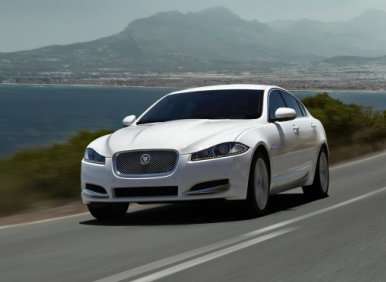
2013 Jaguar XF Supercharged Road Test & Review: Comfort & Cargo
While the exterior treatment of the mid-size Jaguar is firmly rooted in contemporary sensibilities, the old-world craftsmanship and luxury you expect from one of England’s most notable luxury-sports brands is plainly evident—while surprising occupants with decidedly modern touches.
The engine start/stop button pulses red, encouraging your touch to fire the engine. When you do, the gearshift selector rises from the center console and the dash-mounted vents for the HVAC system rotate to reveal their grilles.
Sumptuous leather is accented with aluminum and wood trim in a refreshingly fashionable manner. The controls are illuminated with ice blue lighting, which is both distinctive and easy on the eyes.
All four seating positions provide comfort, although as you might well imagine for a car in this class, rear seat legroom can be a bit tight. Also, that sleek silhouette, tapering as it does to the rear, means headroom in the back seat is a tad compromised as well as outward visibility for the driver.
On the other hand though, at 17.0 cubic feet, the Jaguar’s trunk is one of the most capacious you’ll find in this class of car.
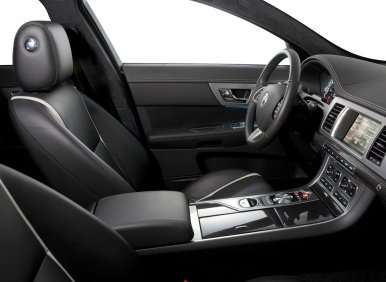
2013 Jaguar XF Supercharged Road Test & Review: Features & Controls
As standard equipment, all Jaguar XF models feature automatic bi-xenon headlights, rear parking sensors, a sunroof, automatic windshield wipers, cruise control, an automatic dual-zone climate control system, heated six-way power front seats with driver memory functions, a power tilt-and-telescoping steering wheel, leather upholstery, and an auto-dimming inside rearview mirror. These features are supplemented by Bluetooth phone and audio connectivity, a seven-inch touchscreen display, and a 250-watt 10-speaker sound system with a CD player and USB/iPod interfaces.
When you go with one of the Supercharged XF models, you’ll also find a blind-spot monitoring system, keyless access and start, a voice control interface, a rear sunshade, and auto-dimming exterior mirrors, Other XF Supercharged standard features include a front parking sensor array, a rearview camera, adaptive front headlights, and a touchscreen navigation system. Further, the Supercharged XF’s heated steering wheel and heated windshield are accompanied by upgraded leather upholstery for the ventilated 16-way front seats. There is also a faux-suede headliner.
The audio package is upgraded to a 380-watt, 12-speaker Meridian premium sound system with satellite radio. Incorporating a 30 gig hard drive, the system can serve as a virtual CD changer—allowing the transfer of up to 10 CDs into memory and playing them back like a physical CD changer would. Gracenote provides artist and track information.
These features pretty much incorporate all of the offerings of the Premium, Convenience, Luxury, and Cold Weather option packages available for the 2.0 and 3.0 versions of the XF. In other words, when it comes to the Jaguar XF, the terms Supercharged and fully loaded are interchangeable.
Rounding out the 2013 Jaguar XF Supercharged’s fit of kit are an Adaptive Dynamics active damping suspension system, which automatically adjusts firmness to accommodate road conditions as well as the way the car is being driven. The Supercharged XF’s Active Differential Control (ADC) helps improve acceleration while enhancing the car’s cornering ability. ADC uses a clutch-type differential to transmit torque to the rear wheel with the most traction. Where conventional traction control uses the brakes to counteract slippage, this system actually decides where to route the engine’s output for best effect.
Supercharged XFs also get bigger brakes, 20-inch wheels and summer tires.
On the options list are adaptive cruise control, an even nicer 825-watt 17-speaker Meridian surround-sound audio system, and 60/40-split-folding rear seats.
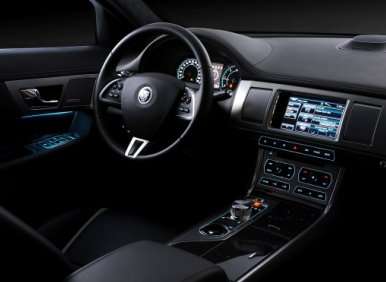
2013 Jaguar XF Supercharged Road Test & Review: Engine/Fuel Economy
A 470-horsepower supercharged 5.0-liter V8 producing 424 ft-lbs of torque powers the 2013 Jaguar XF Supercharged. Peak torque is delivered between 2,500 and 5,500 rpm, which basically means you’re always surfing the crest of this engine’s torque curve.
Remarkably smooth and exceptionally powerful, the Jaguar’s engine provides outstanding thrust while emitting a harmoniously mellifluous sound worthy of the world’s most notable racetracks. The exhaust note is boastfully determined, yet restrained in the sophisticated fashion we’ve come to expect from Jaguar. Accompanied by the insistent murmur of the supercharger, it’s really quite exciting. The new eight-speed automatic transmission shifts cleanly and offers improved fuel economy in addition to improving pulling power.
The XF also incorporates Jaguar Drive Control to give the driver three operating modes; Normal, Dynamic, and Winter. Each mode changes the engine’s response, transmission’s shift behavior, Dynamic Stability Control intervention threshold, the Adaptive Dynamics tuning, and the performance of the Active Differential Control.
The Normal mode is configured to support comfortable, leisurely driving; the Dynamic setting advances responsiveness for a more aggressively sporting character. In this mode, the transmission holds gears to redline to improve acceleration while the suspension system stiffens to improve handling. Winter mode enhances the Jaguar’s capability in low-grip conditions.
XF Supercharged fuel economy is rated at 15 miles per gallon in the city, 23 on the highway, and 18 combined.
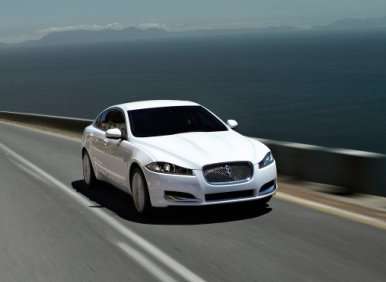
2013 Jaguar XF Supercharged Road Test & Review: Driving Impressions
With Jaguar estimating a zero to 60 of 4.5 seconds, you expect the XF to feel quick, but it really doesn’t. It is quick, but it contains its performance potential so well, there are no dramatic surges to give you an idea of how fast you’re going. You have to look around at the cars around you to get a sense of that. When you notice how quickly other traffic recedes into the distance, then you get a solid idea of the great heaping gobs of speed this car accumulates with ease.
Similarly, it rides so smoothly going down the highway—you just really have to keep an eye on the speedometer. If you rely upon your senses, you’ll be consistently running 20 to 30 miles per hour faster than you think you are. Of course, that’s what a Jaguar is supposed to do, so we ain’t mad about that fact at all.
Comfortable, composed, even dignified around town, when it’s unleashed on the open road, the Jaguar exhibits a thrillingly assertive temperament. We’ve already discussed the aural pleasures of giving the Supercharged XF full throttle. The dynamics of it comply perfectly. The power comes on instantly—with no lag at all—making the Jaguar’s straight-line performance outstanding.
Similarly, when asked for repeated changes of direction in a rapid manner, the Jaguar responds adroitly. Yes, the steering is a bit lighter than we’ve come to appreciate in this, the crème de la crème category in which the XF Supercharged competes, but it is highly responsive nonetheless. Steering feel is a little on the numb side too, but since it responds so immediately we’ll forgive that transgression. Braking is resolute and the transmission matches revs on downshifts to enhance the experience even more.
All in all, the 2013 Jaguar XF Supercharged is a car you’ll enjoy driving.
A lot.
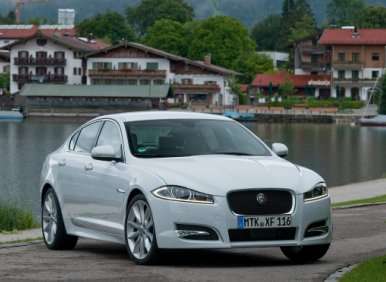
2013 Jaguar XF Supercharged Road Test & Review: Safety Equipment/Ratings
Along with its exceptional performance potential, the Jaguar XF Supercharged offers a host of cutting edge safety technologies. The comprehensive set includes Anti-lock Braking, Dynamic Stability Control, and Cornering Brake Control. Emergency Brake Assist is also standard, while Adaptive Cruise Control (ACC) is available as an option.
The Advanced Emergency Brake Assist system uses the ACC’s radar to calculate your distance from—and your closing speed to—the vehicle ahead. If a certain tolerance is exceeded, the system pre-charges the brake-line pressure to reduce impact speed, as well as providing an audible warning to the driver.
No crash test data is available.
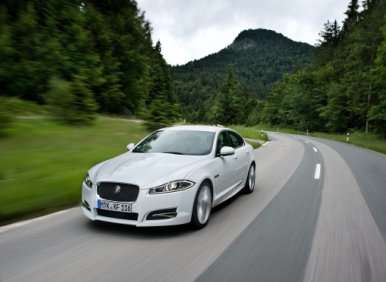
2013 Jaguar XF Supercharged Road Test & Review: Final Thoughts
In all honesty, in this category of cars, unless you really want a Jaguar, odds are the XF Supercharged isn’t going to be your first choice. The Germans have the collective consciousness of the enthusiast population pretty well sewn up in this regard. Further, the Cadillac CTS-V is a very strong competitor here too.
However, what the Jaguar offers that the rest of them can’t really approach is a sense of elegance to go along with the elevated performance potential on display here. Jaguar, (truthfully high-end English cars in general) have a way of deftly combining stupefying performance with palatial luxury in a manner other marques simply don’t approach.
If you’re looking for style, performance, luxury, and a certain fluidity of grace all in one package; there’s really only one choice—Jaguar.
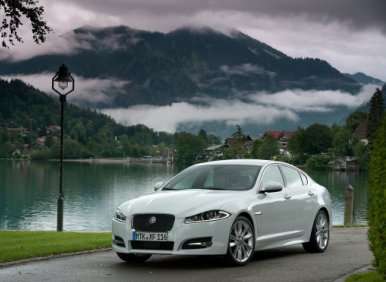
2013 Jaguar XF Supercharged Road Test & Review: Pros & Cons
• Unquestionable style
• Luxurious appointments
• Exciting performance
• Huge trunk
• Poor fuel economy
• Restricted outward visibility
• Slow touchscreen interface
